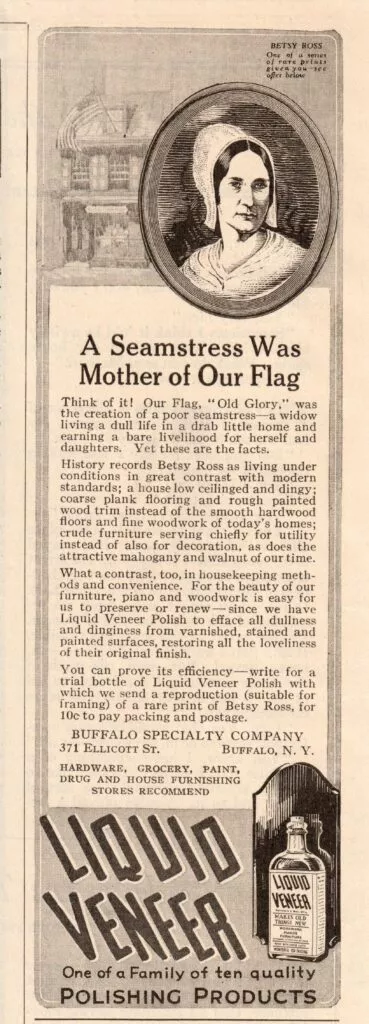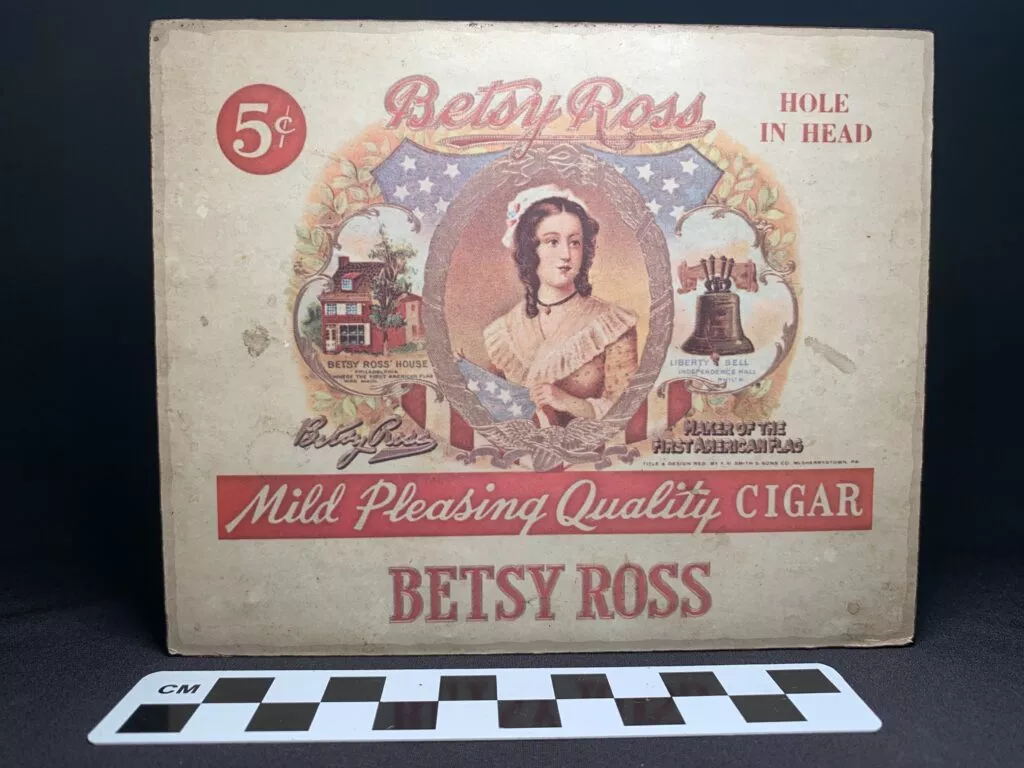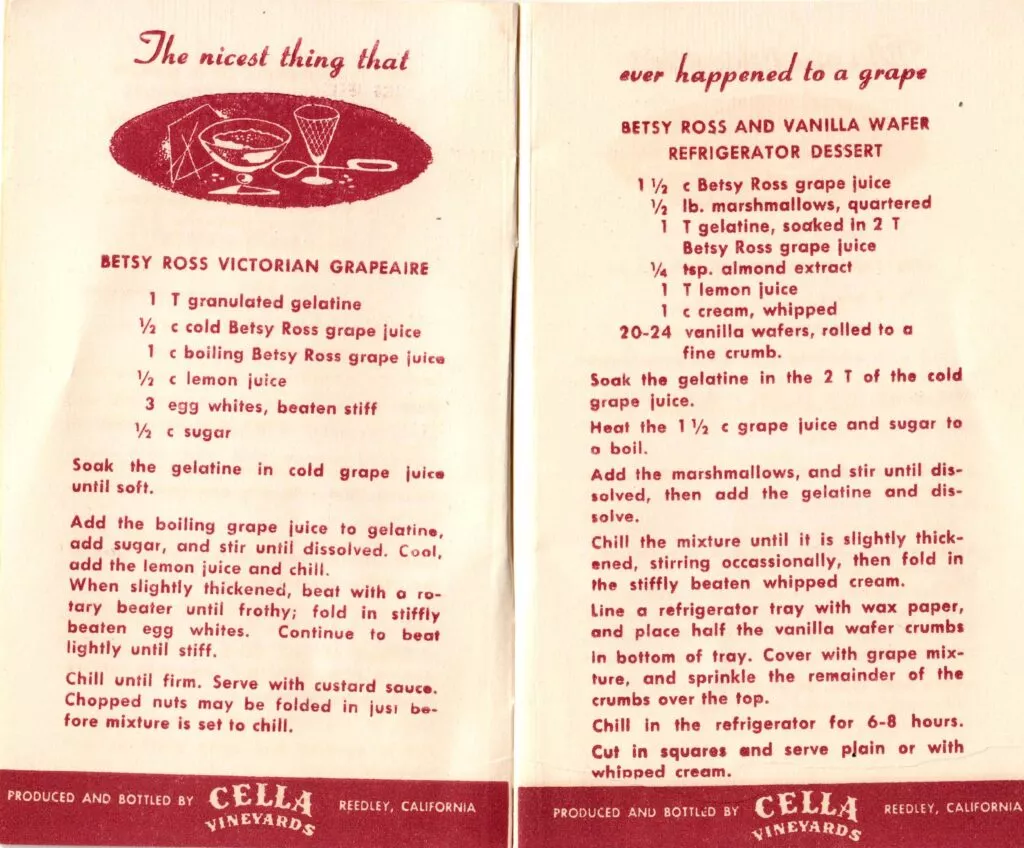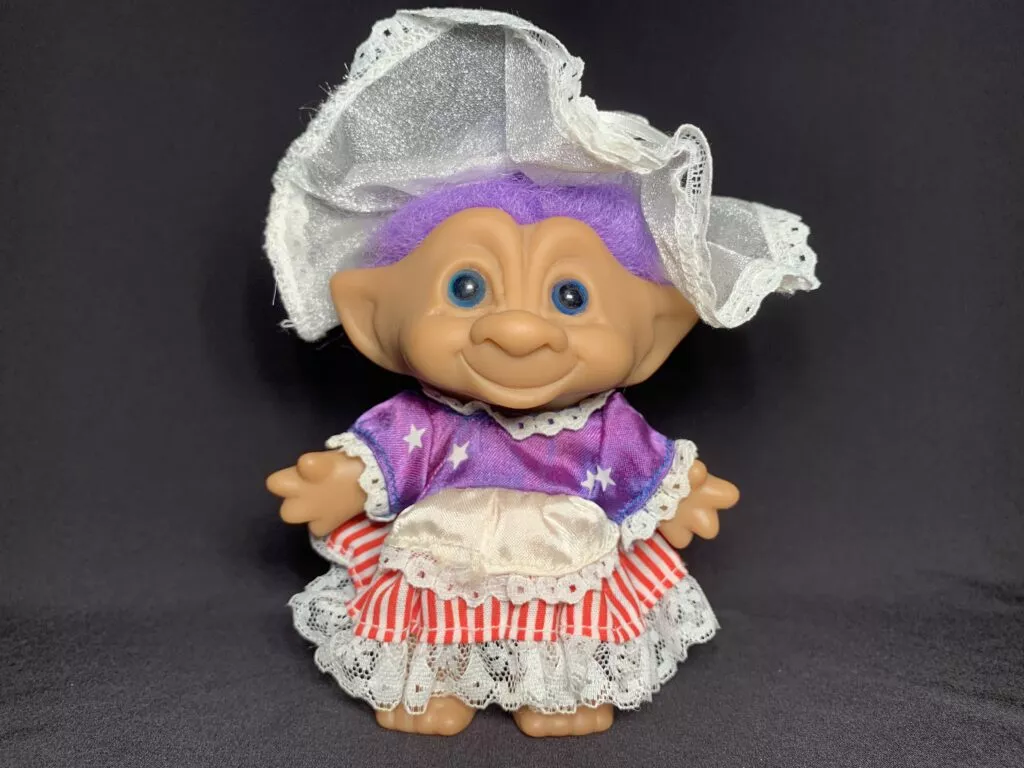
This exhibit was supported by A Friend of the Betsy Ross House.
Kitsch \’kich\, noun, German: a garish or worthless object made to appeal to popular taste for commercial reasons.
What is kitsch? It’s a trinket, a knickknack, a tchotchke. Like the hula girl on your dashboard, kitsch is something charming, cheap, tacky, and sentimental. For over a century, Betsy Ross’ name and likeness have been used as kitsch to advertise a variety of manufactured goods, ranging from predictable to arbitrary. An idealized version of Betsy Ross has sprung from American culture through this kitsch despite there being no surviving image of Ross herself. Ross is represented as a small child, a younger woman, an older woman, and even a mouse and a troll. Interpretation of Betsy Ross’ appearance is as varied as the myriad of ways she is used for the assorted products and advertisements featured in this exhibit.
The Birth of an Icon, 1882-1929
The oldest kitsch object in the Betsy Ross House collection is a late 19th-century cabinet card photo that featured a portrait painting of Betsy Ross. These cabinet cards were sold as souvenirs for 25¢, potentially in Amelia Mund’s Tavern, the last business to occupy 239 Arch Street before it officially became the American Flag House in 1898. This likeness was taken from a painting that was featured in Franklin J. Reigart’s 1878 book The History of the First United States Flag and the Patriotism of Betsy Ross.
An 1882 photo of the Betsy Ross House from that same year by Arch Street photographers R. Newell & Son features a large version of this painting covering the first-floor windows. According to legend, Ross’ living relatives of the time disliked this representation of their descendant. They believed the image to be unattractive and inaccurate.
Iterations of this same image continued to be used into the 20th century. A 1920s advertisement (right) from the Buffalo Specialty Company for their Liquid Veneer polish offered buyers an opportunity to acquire a “rare” print derived from the original painting if they contacted the company for a trial bottle of polish. They only asked an additional 10¢ to cover packaging and shipping costs to receive the bottle and print.
By the early 20th century, different companies offered their own interpretations of Ross’ image for commercial uses. Postcards, sheet music, and ephemeral objects like fans all featured different versions of Ross. In addition to likenesses of the famous flag maker, the Betsy Ross House itself entered the fray as the object of focus for Betsy Ross kitsch. The first example of this from the Betsy Ross collections is a small plate that contained an artist’s interpretation of what the Betsy Ross House looked like in 1778.

Title: Firecracker Postcard
Creator: Raphael Tuck & Sons
Date: 1910-1920
Dimensions: 5.5” x 3.5”

Title: Betsy Ross March Ballad
Creator: Bartley Costello and J. Fred Helf
Location: New York City, NY
Date: 1910
Dimensions: 10.625” x 13.5”

Title: American Emblem
Creator: Harry J. Lincoln
Location: Williamsport, PA
Date: 1923
Dimensions: 9.25” x 12.25”


Title: Betsy Ross Fan
Creator: George P. Diefenderfer
Location: Pennsylvania
Date: 1909-1930
Dimensions: 7” x 13”

Title: Betsy Ross House Souvenir Dish
Creator: Unknown
Date: c. 1925
Dimensions: 5” x 5”


Title: Cigar Box for Betsy Ross Cigars
Creator: F. X Smith & Sons
Location: McSherrytown, PA
Dimensions: 5” x 4” x 6”

Title: Betsy Ross Cigar Advertisement
Creator: A.S. Valentine & Sons
Location: Philadelphia, PA
Date: c. 1900
Dimensions: 20” x 24”
A.S. Valentine & Sons Cigars
Some of the earliest Betsy Ross kitsch took the form of advertising that predominantly focused on a male audience, specifically cigar advertisements. For these companies, Ross embodied their perception of American values like tradition, honesty, and patriotism, and they wanted their products to represent these same values. The first cigar company to take advantage of Ross’ image was A. S. Valentine & Sons.
A.S. Valentine & Sons was founded by Adam S. Valentine (1824-1899). Valentine began his career in the tobacco trade in 1831 at the age of seven as a tobacco stripper for Abraham Harner’s cigar factory in Rehrersburg, PA. Two years later he began rolling cigars for Harner’s. In 1848, Valentine opened his own cigar factory in Womelsdorf, PA at the age of 24. During the second half of the 19th century, Valentine’s business grew, and he expanded to other towns, eventually opening a business at 7th and Arch Street in Philadelphia. He also expanded his business to include his son, officially becoming A.S. Valentine & Son. After Valentine died in 1899, his son George Valentine took over the business. By 1905, the company operated four factories with a combined monthly output of one million cigars. They even had their own baseball team!


Betsy the Homemaker, 1930-1959
By the 1930s, advertisers started using Betsy Ross’ name and image to sell products like food, sewing needles, and beauty supplies and other items for the home. This new Betsy Ross imagery symbolized idealized American societal characteristics of a good wife and homemaker.


(Left & Above)
Title: Betsy Ross Grape Juice Recipe Booklet
Creator: Cella Vineyards
Location: Reedly, CA
Date: 1940-1960
Dimensions: 2.75” x 4.5”


Title: Rubber-tipped Bobby Pins
Creator: Lou Sil Products
Date: c. 1940

Title: Betsy Ross Sewing Needles
Creator: The American Needle and Novelty Company
Location: Chicago, IL
Date: Early 20th Century
The use of Ross’ image to sell sewing needles was perhaps obvious, but regardless an intelligent marketing strategy for producers of sewing supplies and, eventually, equipment. Although an upholsterer by trade, Ross had become one of the most identifiable seamstresses in American culture by this time. The use of her image implied generations of quality in companies’ products.
Plunkett-Jarrell Grocers and Coffee Roasters
One of the first food companies to take advantage of the Betsy Ross image for their products was Plunkett-Jarrell Grocers and Coffee Roasters from Little Rock, AR. Plunkett-Jarrell sold Betsy Ross Brand Tea and a line of Betsy Ross Brand dried herbs. Plunkett-Jarrell Grocers was founded by William B. (W.B.) Plunkett (1859-1948) and J.T. Jarrell in 1899. By 1923, Plunkett-Jarrell operated branches in 10 different Arkansas towns.
Plunkett-Jarrell Grocer’s Betsy Ross Brand tea was first advertised in 1912. The advertisement featured a small likeness of Ross seated on a couch making a flag with the words “Queen of All” above her head. An advertisement from 1919 featured the Betsy Ross image most identifiable with the Betsy Ross Brand tea tins. By this time the tea was offered in black and green varieties.
In 1927, Jarrell quit the grocery business and left the company to Plunkett. Plunkett ran the chain another two decades until he died in 1948, leaving the company to his son Ralph. After Ralph died in 1954, Plunkett-Jarrell was purchased by oil magnate Winthrop Rockefeller in 1955. The following year the Little Rock location permanently closed which meant the end of the Betsy Ross Brand tea.
Title: Betsy Ross Brand Tea Tin
Creator: Plunkett-Jarrell Grocer Company
Location: Little Rock, Arkansas
Date: c. 1930
Dimensions: 3.5” x 2.5” x 1.5”

Bicentennial Betsy, 1960-1979
In 1876, centennial fever spread across the nation. In Philadelphia, the Centennial Exposition was held in Fairmount Park to commemorate the 100th birthday of the United States and Betsy Ross’ name started to disseminate into American culture as the maker of the 13-star flag with the help of her living relatives. 100 years later, the bicentennial was a bigger national event than the Centennial 100 years before. Naturally, Betsy Ross was the focus of much of this patriotic zealousness. Different interpretations of her likeness were found on all kinds of products such as drinking glasses, whiskey decanters, and the Betsy Ross Pez dispenser.
Betsy Ross branded products became much kitschier starting in the 1950s and 1960s. The Betsy Ross brand was firmly established in American culture and her likeness started to be found in unexpected places directed toward men, woman, children, and even the entire family. Things like the Betsy Ross Board Game, introduction of Betsy Ross Dolls, and the Betsy Ross Candy Bank were garish and commercial unlike other Betsy Ross branded products before.
Food packaging that featured the Betsy Ross likeness also changed. Rather than a young, resolute woman in Colonial garb she was now a young girl named Betsy accompanied by her boy pal Ross on bread packaging. This colorful and cartoonish interpretation of Betsy Ross was perhaps the most distanced representation yet compared to the real person. Other than the name, little else connected Betsy and Ross bread with the upholsterer.
Ortlieb Beer Brewery
One of the beer companies that released a special edition can for the bicentennial was Philadelphia’s Ortlieb Brewery. Ortlieb’s was founded in 1869 by Civil War Veteran Trupert Ortlieb, who had been making beer at 1248 Germantown Avenue and Third Street since 1866. Ortlieb continued his business at this location until 1879 when he moved to 845 N. Third Street, a location that grew to encompass an entire block. From 1866-1898, Ortlieb operated the company under a number of different names but was officially renamed Ortlieb in 1899 to honor Trupert’s eldest son Henry F. Ortlieb.
Title: Ortlieb Brewery Betsy Ross Bicentennial Can (right)
Creator: Ortlieb Brewery
Location: Philadelphia, PA
Date: 1976
Trupert retired by 1901 and Henry took over the brewery working alongside his five brothers Joseph, William, Frederick, George, and Albert. Joseph became president of the company in 1936 after Henry died and oversaw one of the most prosperous eras in the company’s history following the end of Prohibition. Ortlieb’s continued operating within the Ortlieb family until it was sold in 1981.
The Bicentennial Betsy Ross House can was part of a larger series of 13 different cans they released for the country’s 200th anniversary. The Bicentennial can idea was the brainchild of Henry F. Ortlieb’s grand-nephew Henry A. Ortlieb. They followed up the Bicentennial collector’s series of cans with an Americana series that featured Philadelphia soft pretzel vendors and other local icons.


Branding the Betsy Brand, 1980-present
By the end of the 20th century, some Betsy Ross kitsch transitioned from being branded by Betsy Ross imagery to branding Ross herself. This typically took the form of a doll, plush, or figurine. Minnie Mouse, Troll dolls, Barbies, and more donned Colonial American garb and brandished the 13-Star flag. Rather than being symbolic of stoicism or domesticity as previous advertising had done, Betsy Ross became a costume fitted for collectibles and characters.

Title: Betsy Ross Troll Doll
Creator: Russ Berrie and Company, Inc.
Date: c. 1990
Dimensions: 4” x 5.25” x 2.5”
Along with branding Betsy, physical representations of Ross, in general, became much more common. Precious Moments, Odyssey Toys, Creation Station LLC, Possible Dreams, Bayberry, and other toy and collectible companies released their own versions of Ross. The audience for these objects was a mix of children and adults, but their usage was now decidedly recreational, whether as a toy or piece for decorative display. Rather than being vintage or antique items that aged into kitsch like Betsy Ross cigar advertisements, tea tins, and beer cans, these dolls and figurines were designed to be tchotchkes and made to appeal to popular taste.
Minnie Mouse, Barbie, and Betsy Ross
The Colonial Barbie and “Betsy Ross” Minnie Mouse bean bag plush were each part of larger collector’s series in the 1990s, and in the case of Minnie Mouse, was a character they represented quite often in the later 20th and early 21st centuries.
Colonial Barbie was part of the American Stories Collection, which featured eight different dolls released from 1995-1997. This special edition doll collection included Pioneer Barbie, Pilgrim Barbie, Colonial Barbie, Pioneer Shopkeeper Barbie, American Indian Barbie (#14715), Civil War Nurse Barbie, American Indian Barbie (#17313), and finally, Patriot Barbie. The 13-star Betsy Ross flag is displayed on the box of both the Colonial and Patriot dolls. The Patriot doll wields a golden bell, and the packaging shows Independence Hall in a snowy setting. The 13-star flag is waving in the bottom left portion of the box, and the Liberty Bell adorns the other side. Despite the flag being present on both boxes, the Colonial Barbie is typically credited as the “Betsy Ross” Barbie because of the included story “The Messenger Quilt” and her colloquial garb compared to the ornately dressed Patriot doll.

Title: Colonial Barbie
Creator: Mattel
Date: 1995
Dimensions: 4” x 12.5”

Title: Colonial Barbie, Complete in Box
Creator: Mattel
Date: 1995
Rights: Courtesy of Vera S. Kuipers
The “Betsy Ross” Minnie Mouse from our collections was released circa 2000 along with a “Paul Revere” Mickey Mouse. These patriotic stuffed dolls were created especially for Disney Store locations. This iteration of the “Betsy Ross” Minnie Mouse plush was released around the same time as another version exclusively sold in the World Showcase area of Disney World’s Epcot theme park. This Epcot “Betsy Ross” Minnie held a needle and spool of thread along with an American flag stylized with stars in the shape of Mickey Mouse’s head in the canton. Minnie Mouse was used as Disney’s Betsy Ross stand-in as early as 1974, where she was used for an Ameritex cut-and-sew pattern for a pillow. Her most common appearance as Betsy Ross is on Disney’s collectible pins. Between 1986 and 2008 “Betsy Ross” Minnie Mouse appeared on at least eight different pin designs, with the bulk of them created as limited-edition pins for Independence Day and Flag Day.

Title: “Betsy Ross” Minnie Mouse Bean Bag Plush
Creator: Walt Disney Company
Date: c. 2000
Dimensions: 7” x 9” x 3.5”

